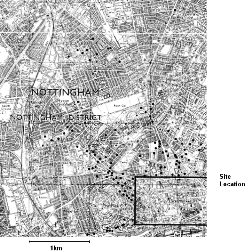
The sandstone, taken ‘en masse’, is a competent rock. Despite the fact that the upper unweathered horizons can be readily excavated without the requirement for rock breakers, bearing pressures within the formation can range between 400kPa and 2000kPa
1. This competency can be attributed to the stratum’s apparent lack of fractures. While relatively closely-spaced joint sets can be viewed on the escarpment west of the Castle, fractures are generally widely spaced, and are not as common throughout the formation as might be anticipated.
Under the microscope, however, we see a completely different picture, the formation’s upper sections exhibiting a notable lack of cement. Under the electron microscope, the predominant mineral components (quartz grains) are not ‘bound’ together. Any cement within the formation consists mainly of calcite, which through the percolation of groundwater over the last 250 million years has been leached out. This is not surprising, given that the formation is a sub-division of the largest major aquifer in the UK (namely, the Sherwood Sandstone Group, Lower and Middle Triassic). Groundwater is therefore a common feature. The calcite that has been dissolved out tends to have been transported downwards and redeposited closer to the base of the formation.